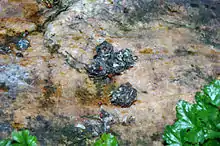Spraint
Spraints are typically identified by smell and are known for their distinct aromas, the smell of which has been described as ranging from freshly mown hay to putrefied fish.[2] The European otter's spraints are black and slimy, 3–10 cm (1–4 in) long and deposited in groups of up to four in prominent locations near water. They contain scales, shells and bones of water creatures.[3] Because of the decline of otters in Britain, several surveys have been made to record the distribution of the animal, usually by recording the presence of spraint. [4] Further, there is some evidence that spraint density is correlated with otter density.[5]

European otter spraint
| Look up spraint in Wiktionary, the free dictionary. |
Spraint is the dung of the otter.[1]

European otter spraint
References
- Matt Pagett (2007), What Shat That?: A Pocket Guide to Poop Identity
- "Spraint Analysis". OTTERSITE. Archived from the original on 8 September 2012.
- Brown, RW, Lawrence, MJ & Pope, J (1984). Animals. Tracks & Signs. Hamlyn. p. 225. ISBN 0-600-57444-X.CS1 maint: multiple names: authors list (link)
- "The Eurasian Otter (Lutra lutra)". Conserving Natura 2000 Rivers. English Nature. Archived from the original on 14 February 2009. Retrieved 27 July 2010.
- Chanin, Paul. "Monitoring the Otter" (PDF). Conserving Natura 2000 Rivers. English Nature. Archived from the original (PDF) on 14 February 2009. Retrieved 27 July 2010.
Further reading
- Hans Kruuk (2006). Otters: ecology, behaviour, and conservation. Oxford biology. Oxford University Press. pp. 79–82. ISBN 9780198565871.
- C. F. Mason & S. M. Macdonald (2009). Otters: Ecology and Conservation. Cambridge University Press. pp. 31–35. ISBN 9780521101349.
This article is issued from Wikipedia. The text is licensed under Creative Commons - Attribution - Sharealike. Additional terms may apply for the media files.